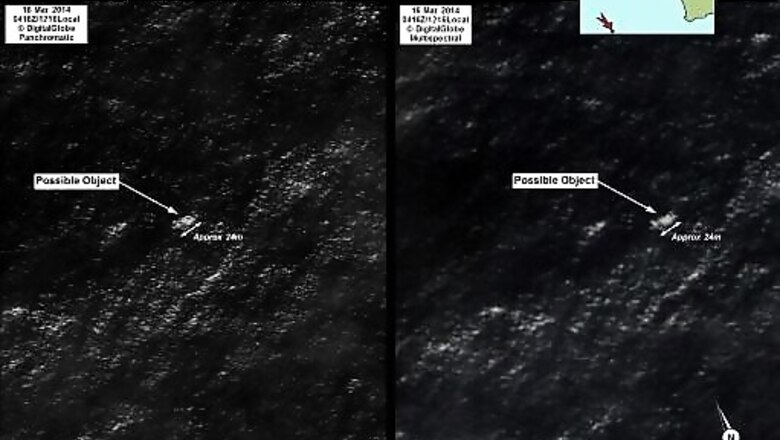
views
Perth: An international search force resumed the hunt for missing Malaysia Airlines Flight MH370 in the remote southern Indian Ocean on Friday as authorities pored over satellite data to try and confirm a potential debris field.
The Australian-led mission said it was sending five aircraft back to a storm-lashed area some 2,500 km (1,500 miles) southwest of Perth. The search began on Thursday after analysis of satellite images identified two large objects floating in the ocean there that may have come from the Boeing 777 which went missing 13 days ago with 239 people aboard.
Investigators have said it is a credible lead but nothing beyond that. The search for the plane continues in other regions, including a wide arc sweeping northward from Laos to Kazakhstan.
The investigators suspect Flight MH370, which took off from Kuala Lumpur for Beijing shortly after midnight on March 8, was deliberately diverted thousands of miles from its scheduled path. They say they are focusing on hijacking or sabotage but have not ruled out technical problems.
A source close to the investigation said it might take "several days" to establish whether the objects spotted by satellite in the Indian Ocean came from the missing airliner.
A former senior crash investigator said there had been false leads in many investigations, especially in waters containing stray containers or dumped and lost cargo.
Three Australian P3 Orions would be joined by a high-tech U.S. Navy P8 Poseidon aircraft and a civilian Gulfstream jet to search the 23,000 square km zone on Friday, the Australian Maritime Safety Authority (AMSA) said. A Norwegian merchant ship that had been diverted to the area on Thursday was still searching there and another vessel would arrive later on Friday.
China's icebreaker for Antarctic research, Xuelong, or Snow Dragon, will set off from Perth to search the area, Chinese state news agency Xinhua cited maritime authorities as saying.
About two-thirds of the missing plane's passengers were Chinese nationals.
Australia's acting Prime Minister Warren Truss said Australia continued to examine satellite footage to pinpoint the location of the suspected debris, which included a piece estimated from the satellite imagery to be 24 meters (79 feet) long.
"Clearly, there's a lot of resources being put into that particular area. It's broadly consistent with the flight plans that were talked about ever since the satellites and their work has been added to the information bank," Truss told ABC radio.
"That work will continue, trying to get more pictures, stronger resolution so that we can be more confident about where the items are, how far they have moved and therefore what efforts should be put into the search effort."
Dire Weather
Strong winds, cloud and rain had made searching on Thursday difficult, said Kevin Short, an air vice marshal in New Zealand's Defence Forces, which sent a P-3K2 Orion to search the area.
"The crew never found any object of significance," he told Radio New Zealand. "Visibility wasn't very good, which makes it harder to search the surface of the water," he said.
A nearby desolate group of French-administered sub-Antarctic islands including St. Paul and Amsterdam and Kerguelen had been asked to look for debris, but none had been spotted, said Sebastien Mourot, chief of staff for the French prefect of La Reunion.
There have been many false leads and no confirmed wreckage found from Flight MH370 since it vanished off Malaysia's east coast, less than an hour after taking off.
There has also been criticism of the search operation and investigation, as more than two dozen countries scramble to overcome logistical and diplomatic hurdles to solve the mystery.
Investigators piecing together patchy data from military radar and satellites believe that, minutes after its identifying transponder was switched off as it crossed the Gulf of Thailand, the plane turned sharply west, re-crossing the Malay Peninsula and following an established route towards India.
What happened next is unclear, but faint electronic "pings" picked up by one commercial satellite suggest the aircraft flew on for at least six hours.
A source with direct knowledge of the situation said that information gleaned from the pings had been passed to investigators within a few days, but it took Malaysia more than a week to narrow the search area to two large arcs - one reaching south to near where the potential debris was spotted, and a second crossing to the north into China and central Asia.
The four-day delay in identifying satellite images that may show debris was due to the vast amount of data that needed to be analyzed by various agencies, Australian authorities and the U.S. company that collected the images said.
The satellite images, provided by U.S. company DigitalGlobe, were taken on March 16, meaning that the possible debris could by now have drifted far from the original site.
The relatively large size of the objects would suggest that if they do come from the missing aircraft, it was largely intact when it went into the water.
Still, finding any debris, let alone the "black boxes" that could shed light on what happened, remains incredibly challenging in the remote, deep-sea region known as the Roaring 40s for its huge seas and frequent storm-force winds.




















Comments
0 comment